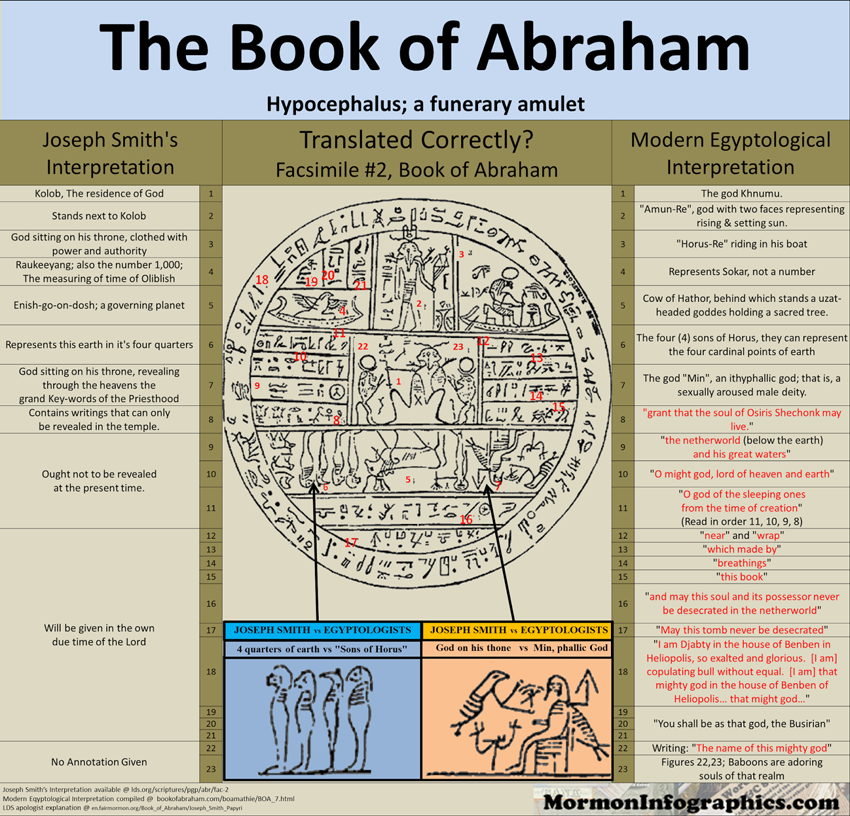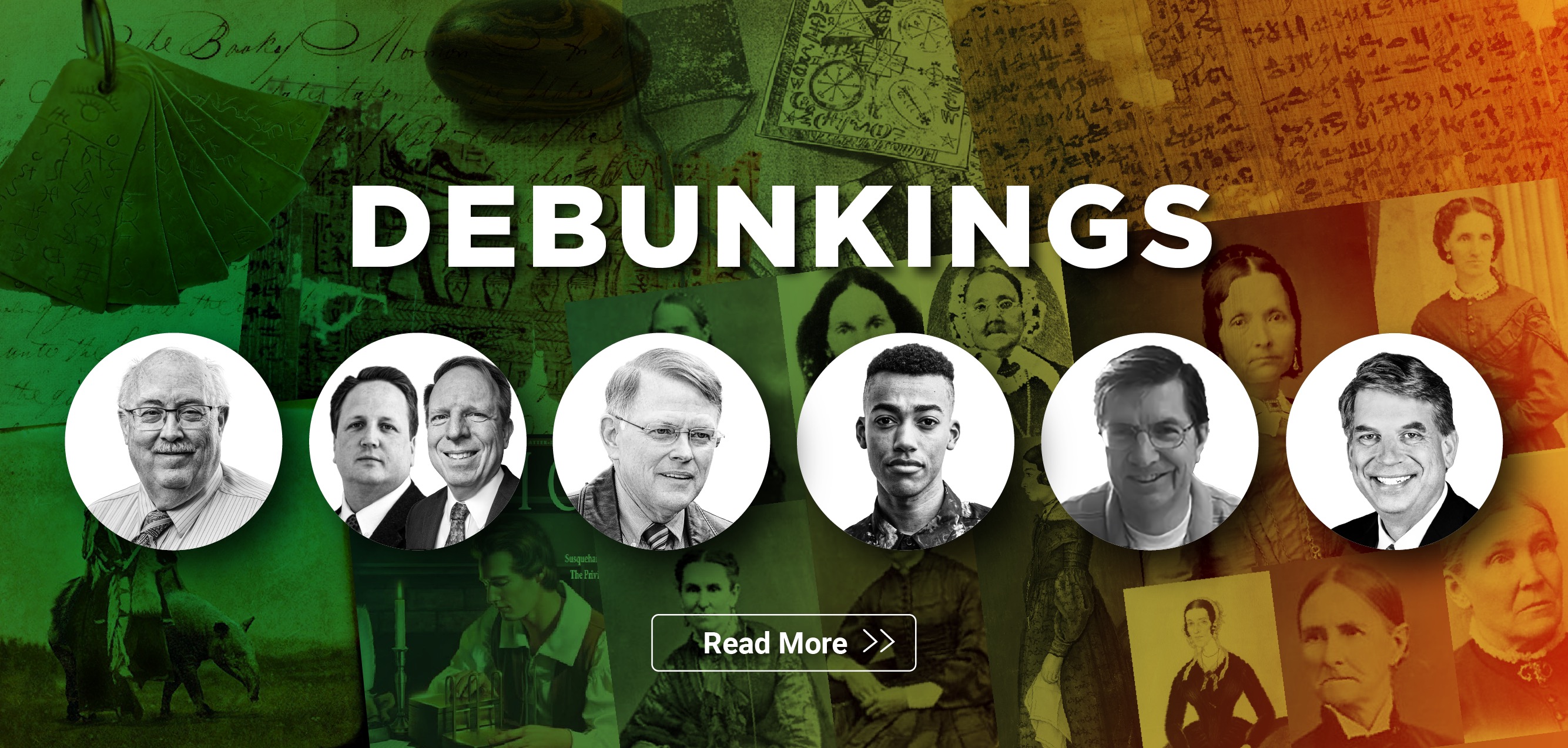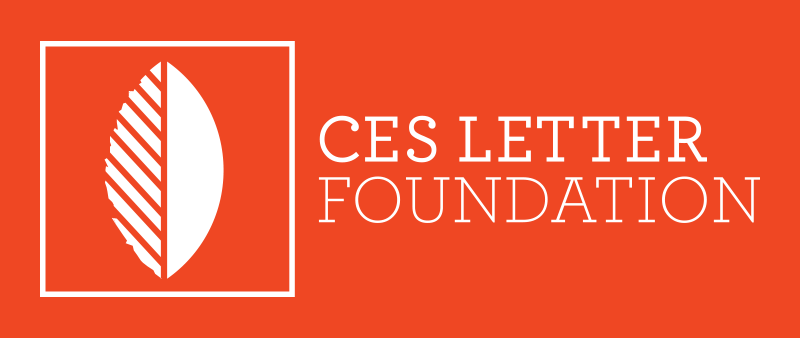Detailed Response
Book of Abraham
Scholars have found the original papyrus Joseph
translated…nearly 2,000 years after Abraham
"Scholars have found the original papyrus Joseph translated and have dated it in first century AD, nearly 2,000 years after Abraham could have written it."
- FairMormon agrees that papyri used by Joseph Smith for translating the Book of Abraham is a 1st century AD pagan Egyptian Funerary document written 2,000 years after Abraham lived and does not match the text of BoA.
Correct:
The papyrus is dated much later than Abraham. Hugh Nibley suggested that the phrase “by his own hand upon papyrus” was a part of the original title of the ancient text.
FairMormon deleted their above response. See screenshot.
Jeremy's Response
What “ancient text” is FairMormon referring to? The papyrus? It’s clear that the papyrus used by Joseph Smith to translate the Book of Abraham has nothing to do with Abraham or the Book of Abraham. It is a pagan Egyptian funerary document dated 2,000 years after Abraham lived. There is nothing on the papyrus that even comes close to anything with “by his own hand upon papyrus.” It was a Breathing Permit which the pagan Egyptians buried with their dead.
There is a reason why Joseph made the claim that it was “written by his [Abraham's] own hand upon papyrus and found in the catacombs of Egypt.” Joseph was very clear that the actual papyri in his possession and which he used to translate for the Book of Abraham and which was rediscovered in 1966 is the original ancient document penned by Abraham himself.
Mormon apologist Hugh Nibley’s opinion on what the original title of some supposed ancient text is just his speculative opinion, which is not backed by any evidence. In fact, the evidence overwhelmingly contradicts Nibley’s speculative opinion.
However, Kirtland Egyptian Paper (KEP) - A1 has the following caption: “Translation of the Book of Abraham written by his own hand upon papyrus and found in the catacombs of Egypt.” This seems to indicate that the phrase "by his own hand upon papyrus" is a 19th-century addition to the text by either Joseph Smith, or the two scribes in whose handwriting the documents are written in, viz., W. W. Phelps and Willard Richards, respectively. This is bolstered by the addition of the phrase “and found in the catacombs of Egypt” that appear in KEPA 1. The phrase "found in the catacombs of Egypt" would not have appeared on the papyrus itself.
FairMormon deleted their above response. See screenshot.
Jeremy's Response
I must point out that this claim completely contradicts the preceding FairMormon argument that the phrase “by his own hand upon papyrus” was part of the original title of the ancient text.
In any event, we know that “by his own hand upon papyrus” and “found in the catacombs in Egypt” does not appear on the papyri because scholars can read Egyptian and have dated it 2,000 years after Abraham lived. So, they are obviously 19th century additions by Joseph Smith & Co.
What matters here is that Joseph Smith made the claim (and it’s still written in scripture) that the writing on the papyrus was penned by Abraham himself, which has been proven false by the physical evidence. The papyrus has nothing to do with Abraham and everything to do with pagan Egyptian funerary text penned 2,000 years after Abraham lived.
The Grammar and Alphabet of the Egyptian Language (GAEL) is complete nonsense. Both LDS and non-LDS Egyptologists will not defend it as Joseph’s translation of the characters he copied from the papyri is nonsensical gibberish.
It is obvious from the historical data that Joseph Smith and the early brethren considered the scroll of Horus to be the source of the Book of Abraham (though not, as is argued by the critics, necessarily the Book of Breathings text).
It seems likely that the early brethren, when working with the papyrus, simply assumed that the papyrus in their possession was the actual document written "by the hand of Abraham." In other words, they would have thought that Abraham himself physically wrote on the papyrus in their possession. As Michael Ash explained, “it seems reasonable to conclude that Joseph may have believed that Abraham himself, with pen in hand, wrote the very words that he was translating... Joseph, by way of revelation, saw that the papyri contained scriptural teachings of Abraham and it would have been natural, therefore, to assume that Abraham wrote the papyri.”
FairMormon deleted their above response. See screenshot.
Jeremy's Response
This is an example of FairMormon’s “prophets aren’t really prophets” version of Mormonism.
"It is obvious from the historical data that Joseph Smith and the early brethren considered the scroll of Horus to be the source of the Book of Abraham.”
FairMormon is acknowledging that the Prophet Joseph Smith considered the 1st century AD scroll of Horus to be the source of the Book of Abraham. The evidence is conclusive that Joseph used the 1st century AD scroll of Horus, which we now possess, in translating the Book of Abraham. We can now read Egyptian. We know exactly what the scroll of Horus says. We can read in the GAEL what Joseph’s translation of the scroll of Horus is and we can compare to see if Joseph passed the test. Joseph failed the test.
Not only is the evidence conclusive that Joseph believed the Horus scroll to contain the writings of Abraham, he also believed that the Lord himself told him so. Orson Pratt spoke about the event when Joseph first encountered the scrolls:
The prophet took [the scrolls] and repaired to his room and inquired of the Lord concerning them. The Lord told him they were sacred records, containing the inspired writings of Abraham when he was in Egypt, and also those of Joseph, while he was in Egypt… – Orson Pratt, 25 Aug. 1878, Journal of Discourses, 26 vols.
"It seems reasonable to conclude that Joseph may have believed that Abraham himself, with pen in hand, wrote the very words that he was translating... Joseph, by way of revelation, saw that the papyri contained scriptural teachings of Abraham and it would have been natural, therefore, to assume that Abraham wrote the papyri.”
This establishes my point above that Joseph Smith believed, via revelation, that the Horus scroll contained the writings of Abraham. Obviously the implication that Joseph believed the Lord revealed to him the Horus scroll contained the writings of Abraham – when the Horus scroll, in fact, does not – is nothing short of damning.
It has absolutely nothing to do with Abraham or
anything Joseph claimed in his translation of the BOA
The author claims that the Joseph Smith papyri "has absolutely nothing to do with Abraham or anything Joseph claimed in his translation for the Book of Abraham."
- FairMormon agrees that papyri used by Joseph Smith for translating the Book of Abraham is a 1st century AD pagan Egyptian Funerary document written 2,000 years after Abraham lived.
Joseph Smith had in his possession three or four long scrolls, plus a hypocephalus (Facsimile 2). Of these original materials, only a handful of fragments were recovered at the Metropolitan Museum. The majority of the papyri remains lost, and has likely been destroyed.
FairMormon deleted their above response. See screenshot.
Jeremy's Response
This is correct except for "Joseph had in his possession three or four long scrolls." FairMormon offers zero evidence to support the claim that Joseph had "three or four long scrolls" in his possession.
The implied message FairMormon is giving here is that since there were other papyri fragments which were destroyed in the Chicago fire or are lost, they may have contained papyri that Joseph used to translate the Book of Abraham. This theory is false.
The following excellent video gives one of the best, neutral, and concise overviews of the Joseph Smith papyri. It gives a summary of the history of the Book of Abraham, the problems, and the apologetic explanations. It also examines Mormon apologetic claims that other scrolls were possible sources for the Book of Abraham:
The Egyptian characters on the recovered documents are a portion of the ‘Book of Breathings,’ an Egyptian religious text buried with mummies that instructed the dead on how to successfully reach the afterlife. This particular Book of Breathings was written for a deceased man named Hor, so it usually called the Hor Book of Breathings.
FairMormon deleted their above response. See screenshot.
Jeremy's Response
This is correct.
The extant fragments include the original Facsimile 1. The papyri containing Facsimile 2 and Facsimile 3 have never been recovered.
FairMormon deleted their above response. See screenshot.
Jeremy's Response
This is correct.
While the papyri containing Facsimile 2 and 3 have never been recovered, FairMormon does not mention that Joseph made copies of the original vignettes (Facsimile 2 and 3) on those lost/destroyed papyri. This is why they’re called “Facsimiles.”
FairMormon also does not mention that Joseph made translations of each and every one of the vignettes (Facsimiles) he copied from the lost original papyri. We can read the Egyptian characters in the Facsimiles. We know the context and gods in the Facsimiles as well.
Joseph’s translation of each one of the Facsimiles (the context, the gods, who’s male, who’s female, what the Egyptian characters actually say, etc.) is nonsense. We do not need all of the original lost/destroyed papyri in order to be able to assess and test Joseph’s translation claims as Joseph provided copies or facsimiles. We have enough of the original scrolls, copies, and facsimiles to know that Joseph Smith's translations and claims are completely incorrect.
Other than the vignette represented in Facsimile 1, the material on the papyri received by the Church, at least from a standard Egyptological point of view, does not include the actual text of the Book of Abraham. This was discussed in the Church publication, the Improvement Era in January 1968.
FairMormon deleted their above response. See screenshot.
Jeremy's Response
This is correct.
However, there are important omissions here that FairMormon fails to educate their readers on.
From the Egyptologist’s point of view, the papyri have absolutely nothing to do with what Joseph translated in Facsimile 1 and it has nothing to do with the text contained in the Book of Abraham. The papyri are standard pagan Egyptian funerary documents dated 2,000 years after Abraham lived.
FairMormon has subtly implied previously that the rediscovered papyri might not be the source for the Book of Abraham and that Joseph may have received the Book of Abraham from other means such as revelation as opposed to actual direct translation of hieroglyphic characters on the papyri. The evidence does not support this. In fact, the evidence disproves this theory.
Here’s how we know that the papyri are the ones Joseph Smith used for translating the Book of Abraham:
- The Grammar and Alphabet of the Egyptian Language (GAEL). You can view the actual book used by Joseph Smith and his scribes on the Joseph Smith Papers website.
Here’s how the GAEL comes in play with the Book of Abraham:
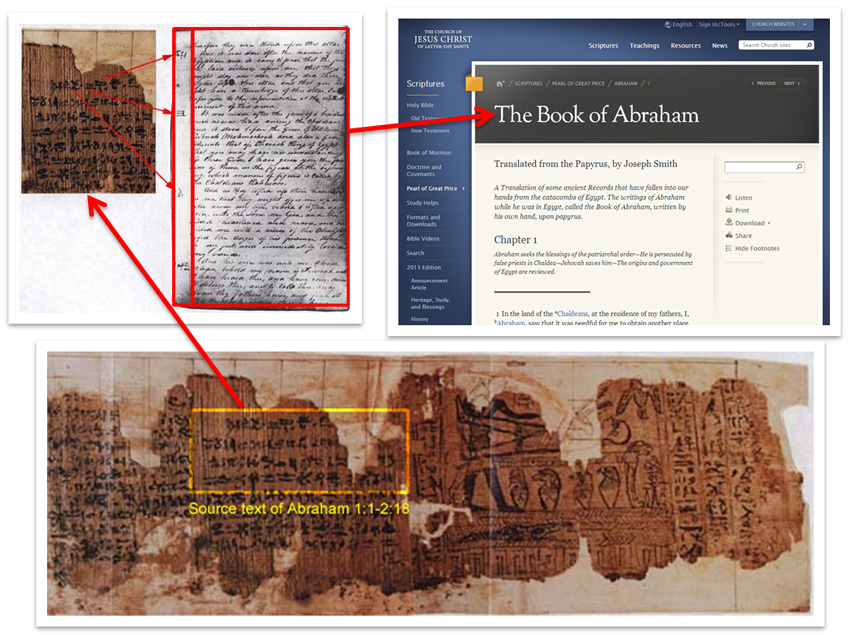
A very detailed look at each hieroglyphic character on the papyrus compared to Joseph’s Grammar and Alphabet of the Egyptian Language (GAEL) can be viewed here.
Quotes to consider:
Scientist Henry Eyring (father of Henry B. Eyring) on the Book of Abraham:
“An example of what I am talking about is the recent discovery of the papyrus scrolls from which Joseph Smith was presumed to have translated the book of Abraham in the Pearl of Great Price. Modern scholars, looking at the scrolls, found nothing they considered to be similar to that book. I remarked at the time that such a finding didn't bother me in the least. God doesn't need a crib sheet in the form of a papyrus scroll to reveal Abraham's thoughts and words to Joseph Smith, with any degree of precision He considers necessary for His purposes. If the only function of the scrolls was to awaken the Prophet to the idea of receiving such inspiration, they would have fulfilled their purpose.”
—Henry Eyring, Reflections of a Scientist, p. 46
FairMormon deleted their above response. See screenshot.
Jeremy's Response
"If the only function of the scrolls was to awaken the Prophet to the idea of receiving such inspiration, they would have fulfilled their purpose.”
Except that this was not the function of the scrolls at all. The scrolls were used as a literal translation by Joseph Smith for the Book of Abraham. The GAEL stands as a testament to this fact. And Joseph Smith believed that the Lord revealed to him that the scrolls contained the writings of Abraham. The theory and claim that Joseph perhaps received the Book of Abraham instead by revelation is flatly contradicted by the evidence.
Faith is believing and hoping when there is little evidence for or against something. Delusion is believing when there is an abundance of evidence against something.
Facsimile 1
The Joseph Smith papyri "has absolutely nothing to do with Abraham or anything Joseph claimed in his translation for the Book of Abraham." The letter then analyzes Facsimile 1, the "lion couch" scene, which Joseph claimed represents an illustration of an attempt to sacrifice Abraham.
- FairMormon agrees that papyri used by Joseph Smith for translating the Book of Abraham is a 1st century AD pagan Egyptian Funerary document written 2,000 years after Abraham lived.
- FairMormon points to irrelevant parallels in an attempt to imply to their Latter-day Saint audience that Facsimile 1 may still have some legitimacy.
The scene represented by Facsimile 1, according to Egyptologists, represents the resurrection of Osiris. In this case, Joseph has used the image to illustrate the attempted sacrifice of Abraham.
FairMormon deleted their above response. See screenshot.
Jeremy's Response
This is correct. Joseph did indeed use the image to illustrate the attempted sacrifice of Abraham, which is part of the problem. What Joseph translated in Facsimile 1 versus what Facsimile 1 actually says and represents are completely different.
One point of interest is that another ‘lion couch’ scene has been discovered which actually includes Abraham's name. Note that it does not claim that Abraham is the figure on the lion couch, and notes that "[t]he figure on the lion couch in this papyrus is a woman.
(See John Gee, Research and Perspectives: Abraham in Ancient Egyptian Texts on lds.org July 1992)

FairMormon deleted their above response. See screenshot.
Jeremy's Response
I am shocked that FairMormon included this in their response.
This image actually comes from an Alchemy (magic) book written 300 years after Christ. Abraham was not an unknown. The same magical book that has this image in it also has Noah turning lead into gold. The magical book basically takes all of the biblical figures of significance and correlates them to Alchemy by rewriting their histories.
Yes, the book incorporates some Egyptian, but that writing with Abraham’s name on it is in Greek. Right there in the picture. It is not Egyptian.
I emailed two respected Egyptologists, Dr. Kara Cooney of UCLA and Dr. Robert Ritner of University of Chicago. I forwarded the image and FairMormon’s claim and asked them to share their professional opinion. Dr. Kara Cooney of UCLA graciously replied back to me on July 11, 2013:
ABRAAM is really there, yes. It's part of a list of names of power, but it doesn't connect to the lion bed at all, and it's not labeling anything on the bed. It's not a label or caption, in other words, but part of its own spell. It's written in Old Coptic with Greek letters, unlike the rest of the papyrus which is written in Egyptian Demotic. At this late Roman period date, Abraham was known. Jews had been living in Egypt since the 6th century BCE, so there was some understanding of Hebrew beliefs. Judaism and Christianity were both practiced in Egypt. Kerry Muhlstein [LDS Egyptologist/apologist] claims that the text says "the person on this couch is Abraham", but there is no truth to this. ABRAAM is simply written with a list of other names of power as part of a magical spell that has nothing to do with anything in the Mormon Book of Abraham or any human sacrifice or anything like that.
Dr. Robert Ritner has confirmed that the text is Roman in date. The Egyptians certainly knew about Abraham by then, but before Christianity, his name was invoked magically. It's a late text.
So, in brief: The name Abraham was written as part of a Coptic magical spell and was not connected to the lion bed at all. I've written to Dr. Robert Ritner, and he has also corroborated this. I hope this helps.
Dr. Kathlyn M. Cooney, Ph.D.
Associate Professor of Egyptian Art and Architecture
University of California, Los Angeles[Note: “[LDS Egyptologist/apologist]” and links added to Dr. Cooney’s email.]
What a book written in another language 2,500 years after the topic in question, which is clearly a work of propaganda for a particular belief system, has to do with the Book of Abraham or topic at hand, I have no idea other than that FairMormon is really grasping at straws here.
Mormon Egyptologist Stephen Thompson agrees:
It is simply not valid, however, to search through 3,000 years of Egyptian religious iconography to find parallels which can be pushed, prodded, squeezed, or linked in an attempt to justify Joseph's interpretations.
He continues in his footnote:
This is the approach taken in many of the apologetic treatments of the Book of Abraham. See, for example, H. Nibley, Abraham in Egypt (Salt Lake: Deseret Book Co., 1981), and "The Three Facsimiles from the Book of Abraham" (Provo, UT: FARMS, n.d.), as well as James Harris, "The Book of Abraham Facsimiles," in R. Millet and K. Jackson, eds., Studies in Scripture, vol. 2, The Pearl of Great Price (Salt Lake City: Randall Book Co., 1985), 247-86, and The Facsimilies of the Book of Abraham, A Study of the Joseph Smith Egyptian Papyri (Payson, UT: by the author, 1990), and M. Rhodes, "The Book of Abraham: Divinely Inspired Scripture," Review of Books on the Book of Mormon (henceforth RBBM) 4 (1992): 120-26. Recently, Daniel Peterson has summarized much of the information found in these works in his "Notes from Antiquity," Ensign 24 (Jan. 1994): 16-21.
What would have been really impressive is if “Abraham” was actually on Facsimile 1 and Joseph’s translation was actually correct, which it isn’t. As FairMormon correctly described above, Facsimile 1 is a Hor Book of Breathings. It has absolutely nothing to do with Abraham as Joseph claimed/translated and it’s dated close to 2,000 years after Abraham lived.
Also of interest is some correlation between The Book of Abraham and the Apocalypse of Abraham, a Jewish document composed between about 70–150 AD. The Apocalypse of Abraham describes the idolatry of Abraham's father in detail, and talks of how Abraham came to disbelieve in his father's gods. The following quotes describe how God told Abraham to leave his father's house so that he would not be destroyed.
15 And as they lifted up their hands upon me, that they might offer me up and take away my life, behold, I lifted up my voice unto the Lord my God, and the Lord hearkened and heard, and he filled me with the vision of the Almighty, and the angel of his presence stood by me, and immediately unloosed my bands;
16 And his voice was unto me: Abraham, Abraham, behold, my name is Jehovah, and I have heard thee, and have come down to deliver thee, and to take thee away from thy father’s house, and from all thy kinsfolk, into a strange land which thou knowest not of;
17 And this because they have turned their hearts away from me, to worship the god of Elkenah, and the god of Libnah, and the god of Mahmackrah, and the god of Korash, and the god of Pharaoh, king of Egypt; therefore I have come down to visit them, and to destroy him who hath lifted up his hand against thee, Abraham, my son, to take away thy life.
VIII. And it came to pass while I spake thus to my father Terah in the court of my house, there cometh down the voice of a Mighty One from heaven in a fiery cloud-burst, saying and crying: “Abraham, Abraham!” And I said: “Here am I.” And He said: “Thou art seeking in the understanding of thine heart the God of Gods and the Creator; I am He: Go out from thy father Terah, and get thee out from the house, that thou also be not slain in the sins of thy father’s house.” And I went out. And it came to pass when I went out, that before I succeeded in getting out in front of the door of the court, there came a sound of a [great] thunder and burnt him and his house, and everything whatsoever in his house, down to the ground, forty cubits.”
FairMormon deleted their above response. See screenshot.
Jeremy's Response
The implicit faith-promoting message here, that FairMormon doesn’t want to outright and directly make (but they’re fine with their Latter-day Saint readers concluding), is that the Apocalypse of Abraham accurately relates history, and that any similarities between the Apocalypse of Abraham and the Book of Abraham demonstrate the accuracy and legitimacy of the Book of Abraham.
So, what about the parallels? There are four:
- Terah was idolatrous.
- God told Abraham to leave the home of his father.
- Abraham was in danger in both stories.
- God would punish idolaters associated with Abraham’s group of origin.
That Terah was idolatrous and that God told Abraham to leave for a new land was information available in the Bible (see, Joshua 24:1-3, Genesis 12:1). If this weren’t enough, there were plenty of early 19th century publications discussing the Midrash in which the idolatry of Terah is expounded.
The nature of the danger to Abraham is inconsistent between the stories: in the Book of Abraham, the danger is that Abraham is going to be sacrificed by the bad guys. In the Apocalypse of Abraham, God is going to send down a lightning bolt to destroy the bad guys, and Abraham needs to get out before that happens. Not exactly an impressive parallel.
The remaining parallel is the idea of God punishing idolaters. Are we supposed to be amazed that two different authors drawing from the Judaic tradition would come up with the idea of God punishing idolaters? Is this the impressive parallel that will prompt apologists to imply that the Apocalypse of Abraham carries some authentic history (or, at least, is a reliable source for earlier Jewish tradition), even though, from a secular standpoint, the odds are negligible?
When you have the luxury of mining for parallels through countless pseudepigrapha and apocrypha, chance alone should turn up more tantalizing connections than this. Is the magical Alchemy book written 300 years after Christ, this “parallel” written in 70-150 AD, and “Four quarters of the earth” the best that FairMormon can provide as support for the Book of Abraham?
What FairMormon doesn’t tell their readers is that Joseph Smith studied Hebrew and Judaism under a private tutor by the name of Joshua Seixas during the translation of the Book of Abraham.
The following image is what Facsimile 1 is really supposed to look like
The author posts an image of a "restored" version of Facsimile 1 found in Charles Larson's book By His Own Hand upon Papyrus: A New Look at the Joseph Smith Papyri. The author states "The following image is what Facsimile 1 is really supposed to look like, based on Egyptology and the same scene discovered elsewhere in Egypt." The Larson restoration shows a second bird instead of a second hand on the reclining figure.
- FairMormon disagrees with Charles Larson’s restoration of Facsimile 1 but fails to note the disagreement is trivial. This is evident when one compares Larson’s restoration with Lanny D. Bell’s restoration.
- FairMormon also fails to tell their readers that Larson and Bell agree on where it matters: Joseph Smith’s reconstruction of Facsimile 1 is nonsense.
Incorrect:
“The Charles Larson restoration of Facsimile 1 has a number of inaccuracies, which are noted by a non-Mormon Egyptologist.”
Quotes to consider
Let me state clearly at the outset my conviction that the questionable traces above the head of the Osiris figure are actually the remains of his right hand; in other words, Joseph Smith was correct in his understanding of the drawing at this point. Ashment 1979, pp. 36, 41 (Illustration 13), is very balanced in his analysis of the problem, presenting compelling arguments for reading two hands; Gee 1992, p. 102 and n. 25, refers to Michael Lyon in describing the "thumb stroke" of the upper (right) hand; cf. Gee 2000, pp. 37-38; and Rhodes 2002, p. 19, concludes: "... a careful comparison of the traces with the hand below as well as the tip of the bird's wing to the right makes it quite clear that it is the other hand of the deceased. "...An important clue is provided in the orientation of the thumbs of the upraised hands toward the face. This is the expected way of depicting the hands of mourners and others when they are held up to (both sides of) their heads or before their faces.
—(non-Mormon) Egyptologist Lanny Bell, "The Ancient Egyptian 'Books of Breathing,' the Mormon 'Book of Abraham,' and the Development of Egyptology in America," Egypt and Beyond: Essays Presented to Leonard H. Lesko upon his Retirement from the Wilbour Chair of Egyptology at Brown University June 2005, (ed. Stephen E. Thompson), Department of Egyptology and Ancient Western Asian Studies, Brown University, 2008, p. 28.
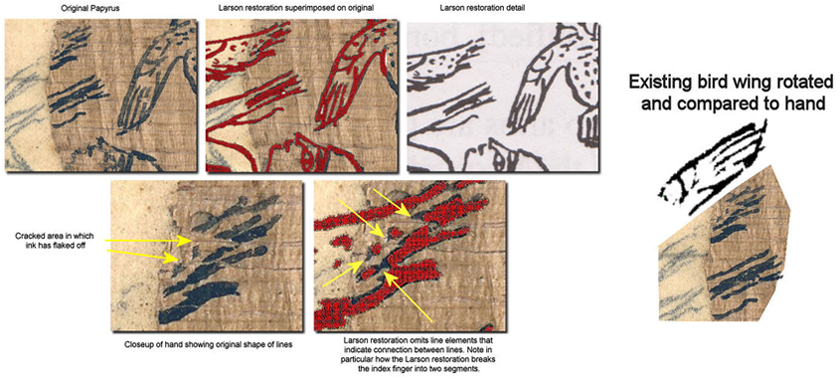
Quotes to consider:
Incorrect:
This image should not be ithyphallic:
...the representation of an ithyphallic figure wearing a kilt would not be unparalleled. However, judging from the position of the erect phallus of the reclining kilted earth god Geb in a cosmological scene on Dynasty 21 Theban coffins now in Turin and Bristol, there would not be enough available space to restore the hand of Anubis, the erect phallus of the Osiris, and the body and wings of Isis in P.JS I: Anubis would have to be grasping the phallus himself and assisting Isis in alighting on it—which is unimaginable...In this area, I believe the Parker-Baer-Ashment reconstruction (with its "implied" erect phallus) is seriously flawed.
- (non Mormon) Egyptologist Lanny Bell, "The Ancient Egyptian 'Books of Breathing'," p. 29
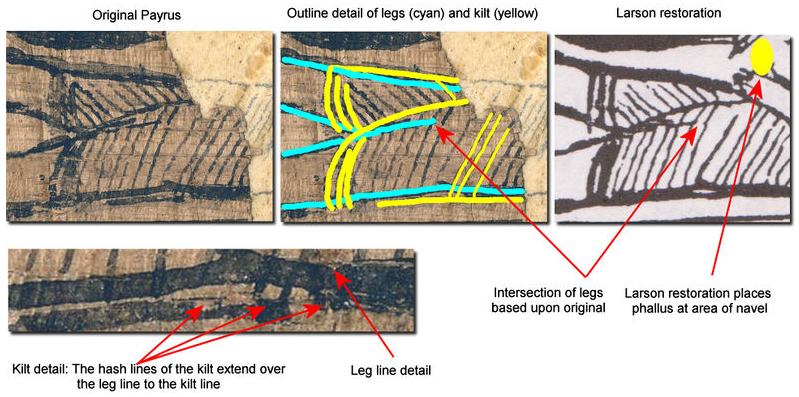
Correct:
One thing that the Larson restoration likely got correct is that the head of the priest should have been the jackal head associated with Anubis.
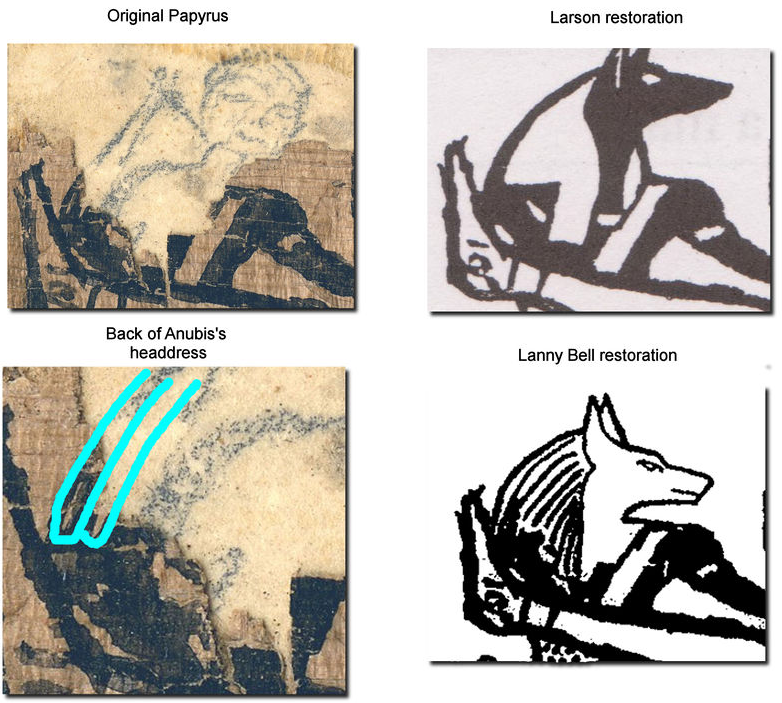
FairMormon deleted their above response. See screenshot.
Jeremy's Response
Who is this “non-Mormon Egyptologist” and what does he really say?
His name is Lanny D. Bell, Ph.D. While FairMormon is claiming that Bell is supporting their position that there are “a number of inaccuracies” in Charles Larson’s reconstruction of Facsimile 1 – which I include in my letter – FairMormon is distracting readers on trivial details while giving their audience the appearance that they have a non-Mormon Egyptologist on their side. FairMormon fails to tell the rest of the story: Larson and Bell ultimately agree where it matters: Joseph’s “translation” and interpretation of Facsimile 1 is complete nonsense.
The following is the Charles Larson reconstruction of Facsimile 1 that I inserted in my letter:
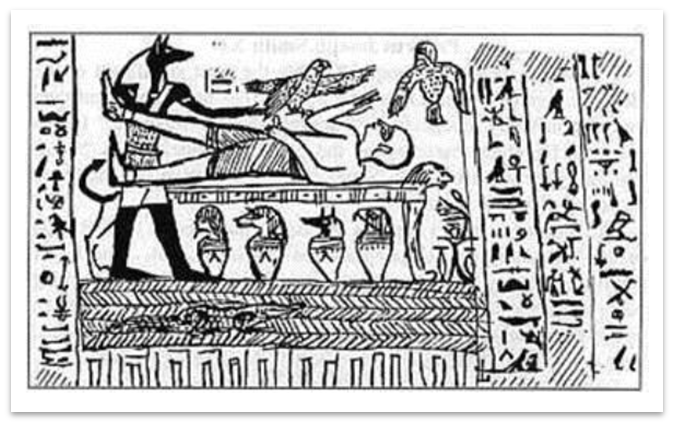
The following is Lanny Bell’s reconstruction of Facsimile 1:
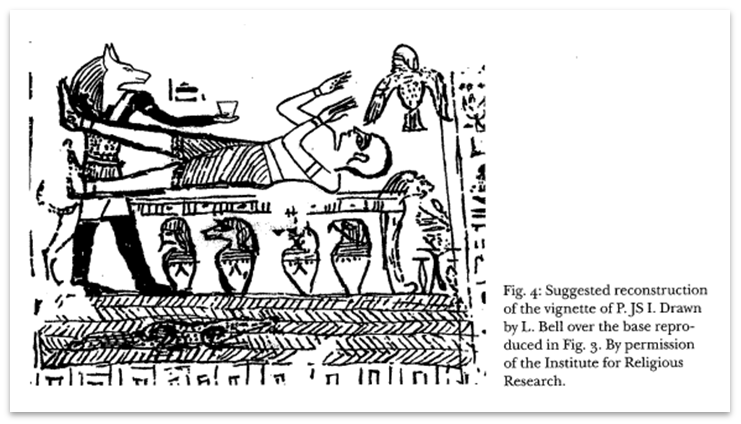
The following is Joseph Smith’s reconstruction of Facsimile 1 contained in the BOA:

Which one of the above Facsimiles more closely match one another?
Let's review the three versions one more time with a closer look:

Note that both Larson and Bell correctly show the jackal head pagan Egyptian god Anubis while Joseph Smith shows a human head representing what he translates as “idolatrous priest of Elkenah.”
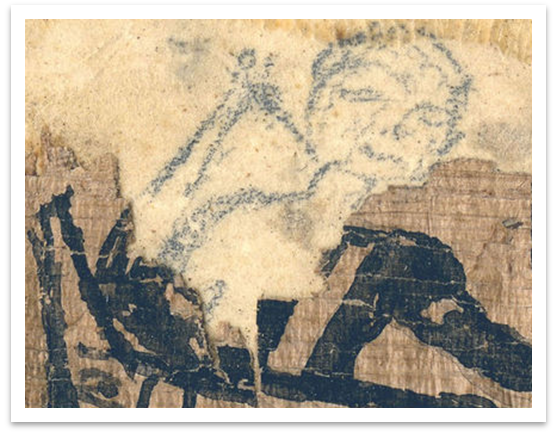
By the way, the above image is Joseph’s rough draft art rendering on the papyri backing paper where the jackal headed god Anubis’ head is supposed to be. Close enough?
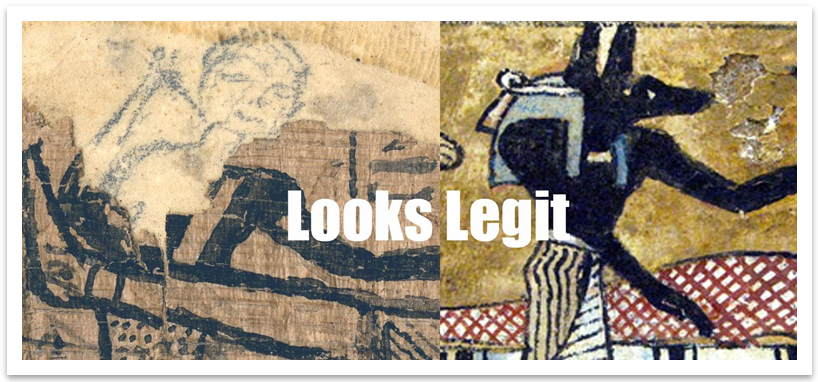
Among FairMormon’s responses: "One thing that the Larson restoration likely got correct is that the head of the priest should have been the jackal head associated with Anubis."
You think? FairMormon admits that Joseph’s reconstruction of Facsimile 1 is wrong as Joseph’s human headed “priest of Elkenah” is supposed to be the jackal headed Anubis, just as Larson and Bell both agree on.
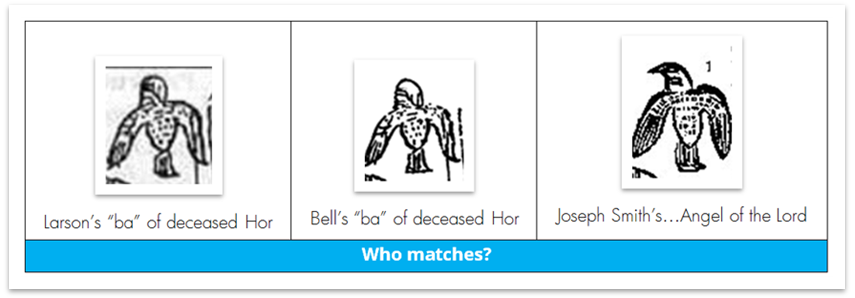
Note that both Larson and Bell correctly show a human-headed bird named "Ba" while Joseph incorrectly has a bird head he misidentifies as "Angel of the Lord."

Ba takes the form of a bird with a human head
Where is FairMormon’s analysis of how Joseph also got this important detail completely wrong? Why isn't FairMormon applying the same nitpicking and critical analysis on Joseph Smith and his Book of Abraham claims and errors that they're applying to Charles Larson's reconstruction?

Note that both Larson and Bell correctly show that the body on the table is not Abraham but rather the Egyptian pagan god Osiris.
FairMormon’s surprisingly candid answer in the next section:
"Facsimile 1 actually depicts the resurrection of Osiris."
Wait a minute, FairMormon...the figure is not Abraham as Joseph Smith claimed in his translation? You’re saying that it instead depicts the resurrection of the pagan Egyptian god, Osiris? Who has absolutely nothing to do with Abraham? Joseph was incorrect in not only his reconstruction of Facsimile 1 but also his interpretation and translation of it as well?
Summary of Facsimile 1:
- Facsimile 1 is a pagan Egyptian funerary text.
- Joseph Smith was wrong with “the priest of Elkenah” as the head is supposed to be the jackal-headed pagan Egyptian god Anubis. FairMormon cannot reasonably claim that the jackal-headed god Anubis can still be the “priest of Elkenah." "Elkenah” or the “priest of Elkenah” do not exist anywhere in Egyptian religion, mythology, or any other historical record in Egypt; or anywhere else for that matter.
- FairMormon and I are in agreement that Abraham is not in Facsimile 1 as Joseph Smith claimed. Rather, the figure on the altar is the resurrected pagan Egyptian god Osiris.
Where are the fancy graphics with red lines and red text showing where Joseph Smith went wrong on his reconstruction, interpretations, and translations of Facsimile 1? Where’s FairMormon’s “analysis” of Joseph’s work? If Joseph was really a prophet and translator, where’s the part in FairMormon’s answer about how Joseph was definitely a translator as he got so-and-so right?
FairMormon is attempting to distract and divert the attention of their readers from where it really matters: Joseph’s reconstruction, interpretations, and translations of Facsimile 1 are absolute nonsense.
The following is a line drawing of what the rediscovered papyri containing Facsimile 1 looks like without the backing paper Joseph glued it on:
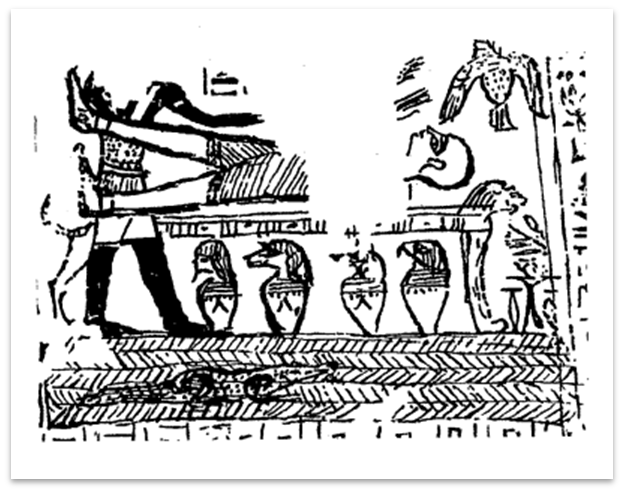
The following is Joseph Smith’s Facsimile 1 reconstruction lined up with the rediscovered papyri. The red circles denote what Egyptologists say is incorrect with Joseph’s reconstruction of Facsimile 1. Notice that all of these red circles are outside of the papyri.
Also note that some of the circles are included in the above comparisons showing where Larson and Bell agree that Joseph was wrong in Joseph’s reconstruction of Facsimile 1:
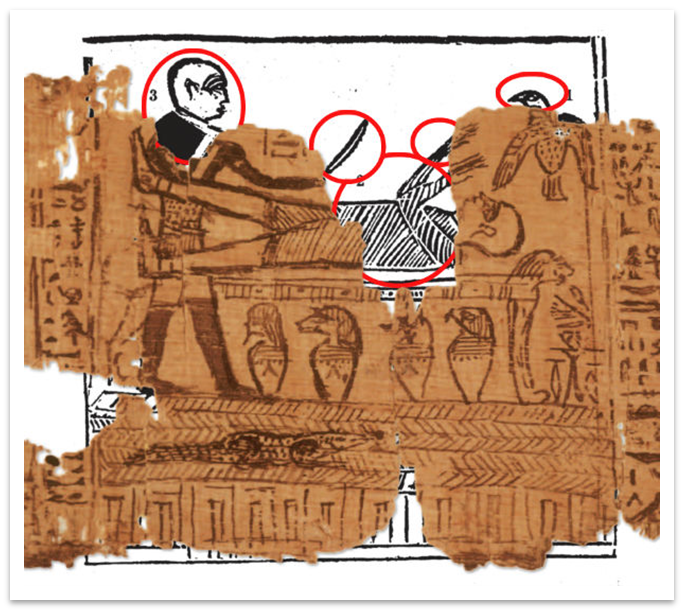
Respected Egyptologist, Robert K. Ritner, Ph.D. – author of The Joseph Smith Egyptian Papyri had this to say about Facsimile 1 and Joseph’s reconstruction of it:
"If you took a painting of Madonna and Child and you tore off the heads of both figures and you replaced them with a dog and a cat, it would be as obvious to us now that this is wrong as the replacing of the clearly jackal head with a human head on this Egyptian piece because we know what these images actually look like. In the same way, we know that those figures would – never under any circumstance – hold a knife. And that’s critical to the text itself (Book of Abraham) because it’s not merely decoration for this text. It goes to the core of the supposed story that accompanies it. If you take the knife away, you take away the story as well. And clearly the knife had no reason to be there."
- Dr. Robert K. Ritner, Ph.D., University of Chicago
Dr. Ritner later did a groundbreaking 3-part interview in 2020 with Mormon Stories going over the Book of Abraham. This series is worth its weight in gold:
Part 1
Part 2
Part 3
To read Dr. Ritner's direct response to the Church's July 2014 Translation and Historicity of the Book of Abraham essay: PDF.
LDS Egyptologist/Apologist Kerry Muhlestein
Note: FairMormon posted two of Muhlestein's videos in their response.
A Mormon apologist and - from what I understand - a not-so-respected BYU Egyptologist, Kerry Muhlestein, made many unsubstantiated claims about the rediscovered papyri, the Book of Abraham, and Joseph Smith’s translations. It’s worth watching the following clip to see how many Mormon apologists respond to the Book of Abraham and what the critics and - more importantly - respected non-LDS Egyptologists have to say in response.
While FairMormon is attempting to distract and divert their readers' attention on irrelevant stripes (kilt), penis, wings, hands, and mummy vs. Osiris differences, FairMormon is failing to tell the rest of the story to their readers that Larson and Bell agree 100% on where it really matters:
- Joseph is incorrect in his translation of the “idolatrous priest of Elkenah” with a human head and a knife. It is instead the jackal-headed pagan Egyptian god Anubis. FairMormon agrees that the figure is supposed to be Anubis.
- The “Angel of the Lord” bird is supposed to be a human-headed bird representing the “ba” of the deceased Hor.
- The body on the altar is not Abraham but rather the resurrected pagan Egyptian god Osiris. FairMormon likewise agrees with this one.
- Under no circumstance would the jackal head Anubis hold a knife as Joseph depicts the “priest of Elkenah” holding in his reconstruction of Facsimile 1.
- Joseph’s translation and interpretation of this 1st century CE pagan Egyptian mortuary scene is nonsense.
- Joseph’s context of the scene with an “idolatrous priest of Elkenah” and Abraham have absolutely nothing to do with what the papyri shows and instead everything to do with being an Egyptian Breathing Permit created close to 2,000 years after Abraham lived.
What matters here is that despite some trivial differences in reconstruction, Charles Larson, Lanny Bell, and every other respected non-Mormon Egyptologist are in agreement that Joseph’s translation and interpretation of the context and content of Facsimile 1 is complete and absolute nonsense.
In fact, Lanny Bell is interviewed twice in the Lost Book of Abraham documentary. Let’s hear from the horse’s mouth – the horse being Lanny Bell, of course – on what he really thinks about Facsimile 1:
You can then hear Lanny Bell’s final verdict regarding Facsimile 1 and Joseph Smith’s claims in which he states:
"From the evidence that we have today, it’s quite safe to say that Joseph Smith did not have the Book of Abraham or the Book of Joseph in front of him in the form of these papyri because they bear no relationship to the contents of his story or to his translation."
In other words, the papyri and Joseph’s Book of Abraham do not match.
At the end of the day? The differences of stripes, a penis, wings and hands and whether the figure on the altar is a mummy or the resurrected god Osiris are all irrelevant and diversionary Egyptology nitpicking. The one single relevant fact that matters in this discussion and which all respected non-Mormon Egyptologists, including Lanny Bell, agree on:
Joseph’s reconstruction and translation of Facsimile 1 has absolutely nothing to do with Abraham or “Priest Elkenah” or anything Joseph Smith claimed. Instead, it has everything to do with being a 1 AD pagan Egyptian Breathing Permit. Lanny Bell does not support the Church or Joseph Smith’s claims of what the papyri and facsimiles represent and claim.
Mummy vs. Resurrection of Osiris
The author states, regarding Facsimile 1: "The following images shows the same funeral scene which has been discovered elsewhere in Egypt. Notice that the jackal-headed Egyptian god Anubis is consistent in every funerary scene."
- FairMormon agrees that Joseph got it wrong that Egyptian jackal headed god Anubis is human headed “Priest of Elkenah”.
- FairMormon disagrees with the "same funeral scene" wording in the CES Letter. I agree with FairMormon and the wording has been updated. However, the wording is trivial and whether it is a mummy or Osiris is irrelevant to the ultimate fact that the figure is not Abraham as translated by Joseph Smith.
Correct:
We agree that Facsimile 1 likely had the jackal head of Anubis rather than the human head, which appears to have been copied from the reclining figure.
FairMormon deleted their above response. See screenshot.
Jeremy's Response
Well, there it is. This is a concession from FairMormon that Joseph’s reconstruction and translation of Facsimile 1 is wrong.
Missing sections of the Facsimiles were filled in before their publication in the newspaper. We do not know if Joseph Smith directed the "restoration" of the missing sections, or if it was done by the engraver, Reuben Hedlock.
FairMormon deleted their above response. See screenshot.
Jeremy's Response
Joseph Smith was the overseer of the project. He was intimately involved. Both scenarios would have required not only Joseph’s permission but also Joseph’s input and management. In order for Hedlock to have filled in the missing sections of the Facsimiles, Hedlock would have had to ask Joseph for access to the papyri, permission to alter or add, and Joseph’s input and feedback after doing so. It is unfathomable that Joseph would have permitted such creative license to Hedlock to add to the papyri and print into the Times and Seasons newspaper without the explicit feedback and approval and knowledge of the prophet. In fact, journal entries show that Joseph was intimately involved in the process:
“Thursday, March 1, 1842 – During the forenoon I was at my office and the printing office, correcting the first plate or cut of the records of Father Abraham prepared by Reuben Hedlock, for the Times and Seasons...”
– History of the Church, Vol. 4, Ch. 30, p.519
“Friday, March 4, 1842 – At my office exhibiting the Book of Abraham in the original to Brother Reuben Hedlock, so that he might take the size of the several plates or cuts, and prepare the blocks for the Times and Seasons; and also give instructions concerning the arrangements of the writing on the large cut, illustrating the principles of astronomy...”
– History of the Church, Vol. 4, Ch. 32, p.543
This is just FairMormon's attempt to distance Joseph Smith from a blatant fraud that the evidence screams he was intimately involved in.
Incorrect:
However, we do not agree that it is the “same funeral scene.” Facsimile 1 actually depicts the resurrection of Osiris. The figure on the couch is alive. The figures to which it is compared all show the preparation of a mummy.
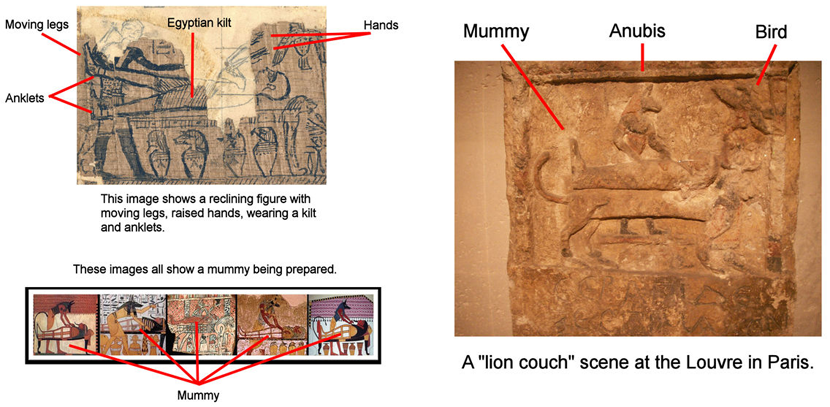
FairMormon deleted their above response. See screenshot.
Jeremy's Response
I find it incredible that FairMormon is spending their time and efforts focusing on Egyptology that proves the point that Joseph Smith was wrong in his translations and reconstruction of Facsimile 1 rather than actually defending Joseph Smith’s translations and reconstruction of Facsimile 1.
In the above example, whether the figure lying on the altar was a mummy or the resurrected pagan Egyptian god Osiris does not matter in this discussion as both still prove the point that does matter: it is not Abraham – as Joseph Smith translated in his Facsimile 1.
Facsimile 2
The author examines Facsimile 2 and compares the way the Joseph and Egyptologists have interpreted the figures.
It should be noted that portions of the original Facsimile 2 appear to have been missing, and that the missing portions were filled in with characters or images taken from other sources before the image was published in the Times and Seasons. Some material was copied from the Joseph Smith papyri. Among the missing sections may have been the area identified as section #3, which matches a figure which appears on Joseph Smith Papyrus IV.
FairMormon deleted their above response. See screenshot.
Jeremy's Response
I take my hat off to FairMormon for admitting this. In other words, Joseph Smith copied characters and symbols from Hor’s Breathing Permit (also known as the Facsimile 1 papyri) and filled up the missing sections of the Facsimile 2 hypocephalus with the copied characters. Egyptologists who studied Facsimile 2 agree and they have stated that the copied characters on Facsimile 2 are gibberish in the context of the hypocephalus.
Joseph plagiarized portions of other papyri to restore Facsimile 2:
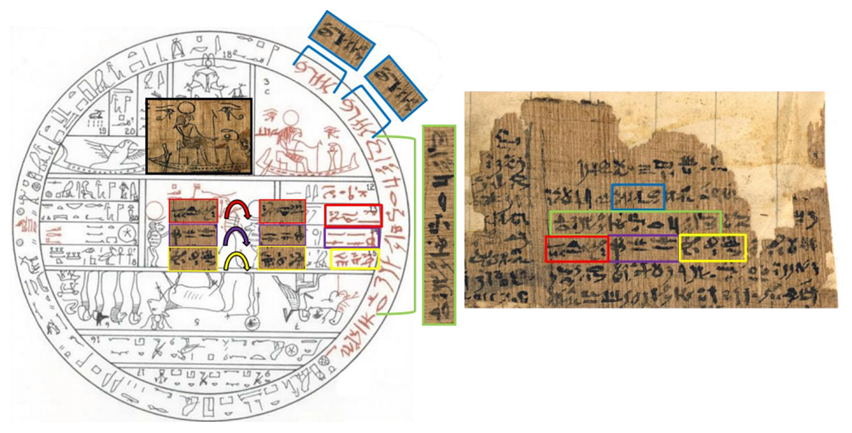
Credit: The Book of Abraham: Criticisms, Defenses, and Implications
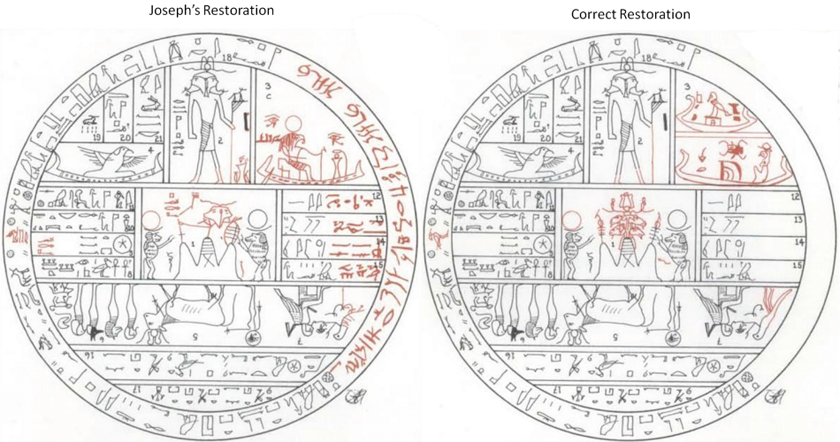
Credit: The Book of Abraham: Criticisms, Defenses, and Implications
For detailed information on the Facsimile 2 hypocephalus and the plagiarism by Joseph & Co. in copying over characters/symbols from Hor’s Breathing Permit, click here.
One interesting thing about this restoration is that the figure in the bark boat actually does appear in this section of at least one other hypocephalus.
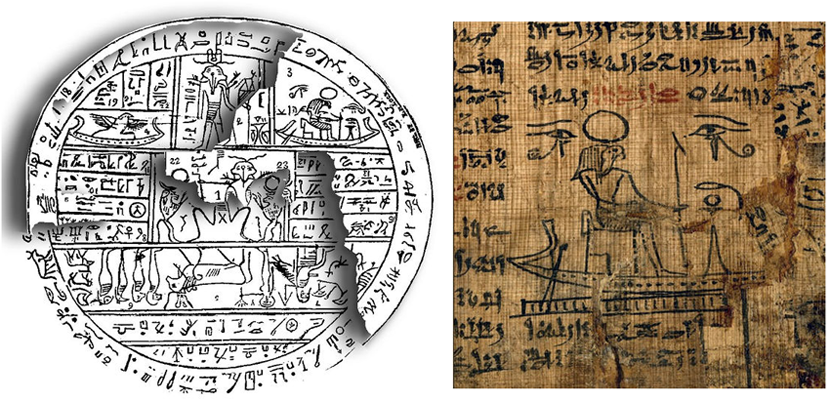
FairMormon deleted their above response. See screenshot.
Jeremy's Response
FairMormon states that the “figure in the bark boat actually does appear in this section of at least one other hypocephalus” while showing the tan colored photo on their right graphic that matches what’s in the missing section (#3) of Facsimile 2 that Joseph filled in.
What’s disingenuous about this is that FairMormon’s tan colored right image comes not from some other hypocephalus but rather from one of the Joseph Smith papyrus scrolls called the “Book of Joseph Papyrus Scroll.” FairMormon deceives their readers into thinking the tan colored right image came from another hypocephalus when it in fact comes from a scroll that Joseph Smith had in his own possession that he copied over to the missing section of the hypocephalus. Most people would not know about the Joseph Smith Papyrus IV or that this tan image came from that scroll. FairMormon knows this.
It’s obvious that FairMormon is betting here on the ignorance of their readers on what’s contained in the other Joseph Smith papyri, specifically the un-translated “Book of Joseph” papyrus scroll.
FairMormon admits that Joseph copied characters and symbols from the Joseph Smith papyri to fill in the missing sections of the hypocephalus. It’s clear that Joseph got the bark boat from the Book of Joseph papyrus scroll in his possession as demonstrated below:

Book of Joseph Papyrus Scroll
(part of papyri collection in Joseph's possession)
As mentioned earlier, Figure 3 containing the boat is actually in the damaged section of the original hypocephalus. As you can see from the three photos below, the same section of the British Museum hypocephalus (far right) is very different than the one in Facsimile 2 (far left). However, notice how similar the middle picture is to the Facsimile 2 in the far left. The middle picture is from the Book of Joseph as demonstrated in the above graphic.
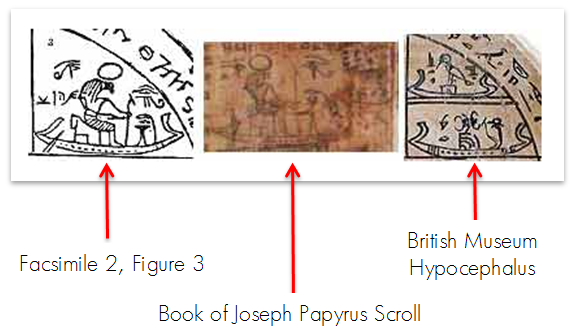
Although FairMormon claims this is "interesting," there’s really nothing amazing, miraculous, or “interesting” about it. Joseph simply plagiarized the bark boat from one of his papyri and had Reuben Hedlock put the Book of Joseph scroll figure onto the Facsimile 2 hypocephalus, where the damage was. As for the location on the hypocephalus, it is not impressive when you consider that there’s a similar looking boat in the exact opposite part of the hypocephalus on the left side in figure #4 of Facsimile 2.
It’s worth posting the following graphic again as a reminder of how wrong Joseph was with Facsimile 2:
Facsimile 3
"Egyptologists state that Joseph Smith’s translation of the papyri and facsimiles are gibberish and have absolutely nothing to do with what the papyri and facsimiles actually are and what they actually say....Facsimile 3:
- Joseph misidentifies the Egyptian god Osiris as Abraham.
- Misidentifies the Egyptian god Isis as the Pharaoh.
- Misidentifies the Egyptian god Maat as the Prince of the Pharaoh.
- Misidentifies the Egyptian god Anubis as a slave.
- Misidentifies the dead Hor as a waiter.
- Joseph misidentifies – twice – a female as a male.”
It is quite easy to identify the two female figures in the drawing.
Joseph Smith would obviously also have noted that these figures were female, so it does raise a good question: Why would he deliberately identify two female figures as male? We do not know the answer to this, however, it does suggest that Joseph was using the existing image to illustrate a concept.

FairMormon deleted their above response. See screenshot.
Jeremy's Response
So, FairMormon’s rebuttal is as follows:
- It’s totally obvious they’re females.
- Joseph obviously had to know this.
- Why would Joseph “deliberately” identify two female figures as male? "We don’t know."
- Regardless, Joseph was trying to illustrate a concept.
- What concept was Joseph illustrating? "We don’t know."
Let's pull a side-by-side comparison of Joseph Smith's translation versus Egyptologists on Facsimile 3:
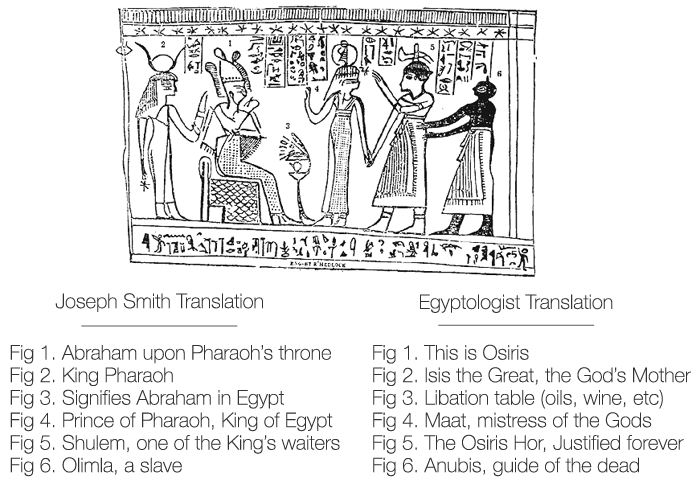
FairMormon fails to explain why Joseph’s misidentification of both the identity and gender of the two female figures was “deliberate.”
“FairMormon...Critical Questions. Faithful answers.” Indeed.
Robert K. Ritner, Professor of Egyptology at the University of Chicago, states that "Smith’s hopeless translation also turns the goddess Maat into a male prince, the papyrus owner into a waiter, and the black jackal Anubis into a Negro slave."
Larry E. Morris notes the following in response to criticism leveled by Professor Ritner at the Book of Abraham:
“Furthermore, Ritner does not inform his readers that certain elements of the Book of Abraham also appear in ancient or medieval texts. Take, for example, Facsimile 3, which depicts, as Ritner puts it, "enthroned Abraham lecturing the male Pharaoh (actually enthroned Osiris with the female Isis)" (JNES, p. 162). In what Ritner describes as nonsense, Joseph Smith claimed that Abraham is "sitting upon Pharoah's throne...reasoning upon the principles of Astronomy" (Facsimile 3, explanation).
Clearly, Joseph Smith's interpretation did not come from Genesis (where there is no discussion of Abraham doing such a thing). From Ritner's point of view, therefore, this must qualify as one of Joseph's "uninspired fantasies." But going a layer deeper reveals interesting complexities. A number of ancient texts, for example, state that Abraham taught astronomy to the Egyptians. Citing the Jewish writer Artapanus (who lived prior to the first century BC), a fourth-century bishop of Caesarea, Eusebius, states: "They were called Hebrews after Abraham. [Artapanus] says that the latter came to Egypt with all his household to the Egyptian king Pharethothes, and taught him astrology, that he remained there twenty years and then departed again for the regions of Syria."
As for Abraham sitting on a king's throne—another detail not mentioned in Genesis—note this example from Qisas al-Anbiya' (Stories of the Prophets), an Islamic text compiled in AD 1310: "The chamberlain brought Abraham to the king. The king looked at Abraham; he was good looking and handsome. The king honoured Abraham and seated him at his side."
Morris concludes,
Ritner may counter that such parallels do not establish the authenticity of the Book of Abraham. That is true, but certainly they deserve some mention. At the very least, these parallels show that "all of this nonsense" is not really an appropriate description of Joseph Smith's interpretation. FairMormonness demands that Ritner, in his dismissal of the content of the Book of Abraham, at least mention similarities between it and other texts about Abraham and point readers to other sources of information.
FairMormon deleted their above response. See screenshot.
Jeremy's Response
Notice that FairMormon and Mormon apologist Larry E. Morris do not disagree with Egyptian scholar and professor Robert Ritner’s assessment:
Smith’s hopeless translation also turns the goddess Maat into a male prince, the papyrus owner into a waiter, and the black jackal Anubis into a Negro slave.
What FairMormon does instead is distract their Latter-day Saint readers from crucial mistranslations while they talk about irrelevant “parallels,” which do not disprove or diminish from Professor Ritner’s above factual statement. Morris later admits the irrelevant parallels do “not establish the authenticity of the Book of Abraham.”
Instead of focusing on how bad Joseph got it wrong, FairMormon instead chooses to complain that Ritner could have been more “fair” by incorporating these impertinent parallels that, by the Mormon apologist’s own admission, do “not establish the authenticity of the Book of Abraham.”
It is difficult to deal seriously with Joseph Smith’s impudent fraud...Smith has turned the goddess [Isis in Facsimile #3] into a king and Osiris into Abraham. – Dr. A.H. Sayce, Oxford professor of Egyptology
Earth in its four quarters
"The following is a side-by-side comparison of what Joseph Smith translated in Facsimile 2 versus what it actually says according to Egyptologists and modern Egyptology." The letter displays a graphic from "mormoninfographics.com" called "The Book of Abraham - Hypocephalus, a funerary amulet," which compares Joseph Smith's interpretations of elements of Facsimile 2 with those provided by Egyptologists.
Correct:
The graphic notes that Joseph may have gotten an element correct: "there is some agreement."
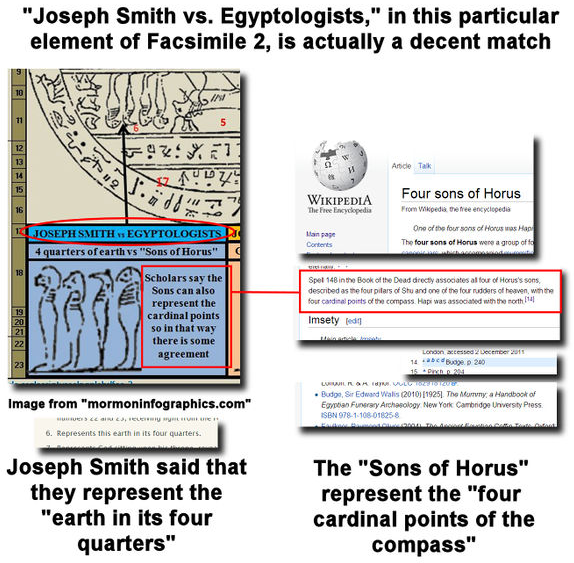
FairMormon deleted their above response. See screenshot.
Jeremy's Response
This is not the home run that apologists claim it to be. For example, the 4 figures (jars) above represent the Four Sons of Horus, which are associated with the four directions of the compass.
However, Joseph identified these four gods as:
Egyptologists say the names of the four gods are actually (from left to right in graphic):

This is an example of FairMormon’s modus operandi and dishonesty. Notice in FairMormon’s above response that they point to the “Four Son of Horus” Wikipedia article where they selectively screenshot only the specific parts that talk about the cardinal points of the compass. This very same Wikipedia article that FairMormon used also debunks Joseph Smith’s “translation” of the four jars as well as what Joseph claimed the names of the four gods were. In FairMormon universe, the facts are irrelevant unless they allow FairMormon to give “faithful answers.”
If you ask a respected Egyptologist to describe these 4 figures in a sentence, you’re going to learn more about the gods, mummification process, and what body parts are stored in each individual jar than you are about four compass directions.
The phrase “four quarters of the earth” is neither groundbreaking nor original. This phrase appears five times in the Book of Mormon, three times in the Doctrine and Covenants, and once in Moses 7:62.
If Joseph really translated the papyri, he would have referred to the figures as the four sons of Horus and given their actual correct names of Imsety, Duamutef, Hapi, and Qebehsenuef. This would have stood as a powerful witness to the truthfulness of the Book of Abraham and Joseph’s claims. Instead, Joseph not only incorrectly misidentifies each one of the four gods associated with the jars but he gives names not found in any Egyptian documents or Egyptology.
The fact that FairMormon is pointing to “earth in its four quarters” as a possible victory for Joseph is a sad and illuminating testament indeed of just how bad of a blow the Book of Abraham is to Joseph Smith and the LDS truth claims.
Min, the pagan Egyptian god of fertility or sex
"One of the most disturbing facts I discovered in my research of Facsimile 2 is figure #7. Joseph Smith said that this is “God sitting on his throne…” It’s actually Min, the pagan Egyptian god of fertility or sex. Min is sitting on a throne with an erect penis (which can be seen in the figure). In other words, Joseph Smith is saying that this figure with an erect penis is Heavenly Father sitting on his throne."
- FairMormon agrees that Joseph identifies Egyptian god of sex, Min (with an erect penis) as “God sitting on his throne."
The Egyptians had multiple gods, each representing a particular characteristic. Latter-day Saints, (and Christians in general), on the other hand, worship one God, who encompasses all characteristics. Thus, Joseph could have identified any Egyptian god in Facsimile 2 as ‘God, sitting on his throne,’ not just Min. He does, in fact, also identify the hawk-headed god Re in the exact same manner. There is no Egyptian representation of the God that we know as ‘God the Father.’
FairMormon deleted their above response. See screenshot.
Jeremy's Response
Using this same logic, ancient gods Zeus, Thor, Apollo, Aphrodite, Ares, Odin are all "God the Father.”
The consequence of this apology by FairMormon is complete and total universalism, which is not a Mormon doctrine consistent with the "One True Church" theology. In this case and from the Mormon orthodoxy perspective, FairMormon is apostate.
This is basically FairMormon fitting a square peg in a round circle. They can force it down with a hammer, but it won't look pretty afterward.
If there is no Egyptian representation of the “God that we know as ‘God the Father’”, then why did Joseph Smith present it as such in his translations of the Facsimiles?
In number 3 of Facsimile 2, Joseph says the Egyptian pagan god of sun, Ra, “represents God” whose crown of eternal light upon his head represents the grand keywords of “the holy priesthood as revealed to Adam in the Garden of Eden, as also to Seth, Noah, Melchizedek, Abraham...”
This is applying Judeo-Christian concepts and mythology to a completely foreign ancient religion, culture, and deity which had no concept of Judeo-Christian gods, or “holy priesthood,” or figures such as Adam, Seth, Noah, Melchizedek, and Abraham during the time of Abraham. It’s an anachronism. A modern example of an anachronism: Your mother posted a Facebook status as a teenager in the 1960s. Obviously, this is not true as Facebook did not exist in the 1960s.
This is like saying that the Greek god Apollo taught baptism by immersion for the remission of sins and receiving the gift of the Holy Ghost by the laying on of hands. Not only would this be absurd, it would be an anachronism.
With regard to the nudity (and the phallus in particular), the Egyptians had no cultural reservations about depicting nudity, unlike our current society. Therefore, the depiction of Min and his phallus is used by critics to create an absurdity: that Joseph would dare to associate such a figure with God the Father. Critics snicker and joke about how silly it was of Joseph to equate ‘Min, the phallic God’ with God the Father. To ancient Egyptians, however, there would be no absurdity in doing so. Joseph simply equated both the god Re and the god Min with "God sitting on his throne."

FairMormon deleted their above response. See screenshot.
Jeremy's Response
Again…by this logic, Zeus, Thor, Apollo, Aphrodite, Ares, Odin and the rest of the gods are all "God the Father.”
Joseph Smith wasn’t an ancient Egyptian and ancient Egyptians’ phallus god, Min, was not the Mormon or Christian god.
What’s absurd is Joseph’s claim that this Egyptian pagan god with an erect penis, Min, is Heavenly Father. This is like someone in the 19th century claiming that the ancient Norse god Odin is Elohim and Odin’s son Thor is Jesus Christ.
It wasn't just the critics who sensed the awkwardness of the Prophet Joseph Smith pointing to an ancient pagan Egyptian sex god with an erect penis as representing our Heavenly Father. The Church sensed it too.
The following are Facsimile 2 in different editions of the Pearl of Great Price. Notice the censorship of Min's penis in the 1902 and 1921 editions before the Church decided in 1981 that it would probably be a great idea to put the penis back on:

Credit: The Book of Abraham: Criticisms, Defenses, and Implications
The ancient Egyptians had their own gods completely independent of Judeo-Christian theology. Their gods did not represent the Christian or Mormon god any more than Zeus or Odin represent Elohim and Hercules or Thor represent Jesus Christ.
It’s obvious from Joseph’s own translations and claims that he believed the Facsimile scenes represented Abraham and Judeo-Christian concepts and theology.
There’s a book published in 1830 by Thomas Dick
entitled ‘The Philosophy of the Future State’
The author claims that the Book of Abraham may be based upon ideas presented in Thomas Dick's book Philosophy of a Future State. The author states that "Joseph Smith owned a copy of the book and Oliver Cowdery quoted some lengthy excerpts from the book in the December 1836 Messenger and Advocate."
Many of the ideas promoted by Thomas Dick were common Protestant beliefs and were therefore available without having to read Dick’s work. Joseph Smith never made any public or written statements indicating that he was aware of or that he had ever read Dick’s book. The only evidence that even suggests the possibility is circumstantial and is based upon the appearance of several passages from A Philosophy of a Future State in the Latter Day Saints’ Messenger and Advocate.
FairMormon deleted their above response. See screenshot.
Jeremy's Response
FairMormon wants you to believe that Joseph Smith was unaware of the book because he “never made any public or written statements indicating that he was aware of or that he had ever read Dick’s book” and that the evidence is “circumstantial.” FairMormon fails to mention to their readers that Joseph owned a copy of the book in his own personal library. He donated his own copy to the Nauvoo Library and Literary Institute on January 31, 1844. Oliver Cowdery – a scribe for the Book of Abraham – quoted extensively in 1836 from the book in the Latter Day Saints’ Messenger and Advocate, the same year that the Book of Abraham was being translated. Further, the book was available in the Manchester library to which was readily available and accessible to Joseph Smith, Oliver Cowdery, and their associates.
FairMormon understandably (due to their mission statement and tagline) fails to connect the dots for their readers. The editor of the Messenger and Advocate, Oliver Cowdery, who inserted excerpts from A Philosophy of a Future State into the newspaper, was also the scribe for the Book of Abraham.
Even if in the extremely unlikely scenario that Joseph Smith had never heard of the book and its ideas? Even if we’re generous in assuming that Joseph didn’t yet have his own copy of the book in 1835-1836? He still had his cousin and trusted advisor and Book of Abraham scribe Oliver Cowdery to introduce the book and its ideas to him. Obviously the book was important and impressive enough for Oliver to feel the need to print excerpts into a public newspaper during the same time that he was scribing for the Book of Abraham. Why wouldn’t Oliver also feel the same need and desire to share the book and its ideas with – of all people – his own cousin and prophet?
Oliver’s statement in the December 1836 Messenger and Advocate newspaper heading:
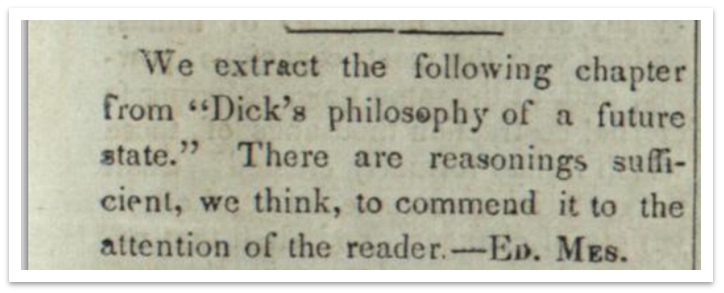
More importantly, Joseph Smith rejected or contradicted many of the ideas put forth by Dick in A Philosophy of a Future State. It is therefore unlikely, contrary to Fawn Brodie’s speculation in her book No Man Knows My History: The Life of Joseph Smith, that Joseph had been ‘recently reading’ Dick’s work and that it made a ‘lasting impression’ upon the Prophet.
FairMormon deleted their above response. See screenshot.
Respected LDS historian and scholar Klaus J. Hansen disagrees with FairMormon:
The progressive aspect of Joseph’s theology, as well as its cosmology, while in a general way compatible with antebellum thought, bears some remarkable resemblances to Thomas Dick’s ‘Philosophy of a Future State’.
Hansen continues:
Some very striking parallels to Smith’s theology suggest that the similarities between the two may be more than coincidental. Dick’s lengthy book, an ambitious treatise on astronomy and metaphysics, proposed the idea that matter is eternal and indestructible and rejected the notion of a creation ex nihilo. Much of the book dealt with the infinity of the universe, made up of innumerable stars spread out over immeasurable distances. Dick speculated that many of these stars were peopled by “various orders of intelligences” and that these intelligences were “progressive beings” in various stages of evolution toward perfection. In the Book of Abraham, part of which consists of a treatise on astronomy and cosmology, eternal beings of various orders and stages of development likewise populate numerous stars. They too, are called “intelligences.” Dick speculated that “the systems of the universe revolve around a common centre…the throne of God.” In the Book of Abraham, one star named Kolob “was nearest unto the throne of God.” Other stars, in ever diminishing order, were placed in increasing distances from this center. – Mormonism and the American Experience, Klaus Hansen, p.79-80, 110
By the way, Klaus J. Hansen is respected by both FairMormon and Neal Maxwell Institute. They have used his work as reference to support their positions, including this review on Neal Maxwell Institute’s website, which FairMormon also links to on their website.
Just like the View of the Hebrews, FairMormon is playing with words: “Joseph Smith rejected or contradicted many of the ideas put forth by Dick in A Philosophy in a Future State.” FairMormon fails to also mention that Joseph Smith also accepted and believed many of the ideas put forth by Dick’s book. This all-or-nothing approach by FairMormon is a diversionary tactic to take their readers' attention off the evidence of an otherwise damaging book.
One common theme coming from FairMormon is their attack on David O. McKay’s niece, Fawn Brodie, and her 1945 book No Man Knows My History. I heard about this book as a believing Mormon but only in the context that it’s “anti-Mormon” and “full of lies”. When I read the book during my faith transition in 2012, I found it to be the opposite of what I heard as a believing Mormon.
In fact, the following is what LDS Ronald O. Barney from the Church’s Joseph Smith Papers project had to say about Fawn Brodie and No Man Knows My History:
“…her book, is by all accounts, well-written.”
“Fawn Brodie’s claims about Joseph Smith eventually brought censure to her from the Church and she was ‘un-Churched’.”
“There were some attempts to respond to what [Brodie] had to say but they were absent the kind of historical scrutiny that she had applied to the whole milieu of Joseph during his lifetime.”
Respected LDS Scholar and Historian Richard Bushman extensively used No Man Knows My History as a source in his Rough Stone Rolling biography of Joseph Smith.
So, despite FairMormon’s attempt to define Brodie and No Man Knows My History as basically “just another anti-Mormon book full of lies,” many respectable LDS scholars and historians disagree with FairMormon’s positioning and mischaracterization of Fawn Brodie and her book.
Elder Holland asked about papyri not matching Book of Abraham in 2012 BBC interview
Elder Jeffrey R. Holland was directly asked about the papyri not matching the Book of Abraham in a March 2012 BBC interview:
Sweeney: Mr. Smith got this papyri and he translated them and subsequently as the Egyptologists cracked the code something completely different…
Holland: (Interrupts) All I’m saying…all I’m saying is that what got translated got translated into the word of God. The vehicle for that, I do not understand and don’t claim to know and know no Egyptian.
- FairMormon agrees. FairMormon takes it much further by not only admitting that the papyri fragments do not match the text of the Book of Abraham but that Elder Holland knows this. I ask FairMormon to share the source for Holland’s knowledge.
The Church has known and publicly acknowledged in the Improvement Era that the papyri fragments do not match the text of the Book of Abraham since 1968 (for over 45 years). This isn’t something new. Elder Holland knows this.
FairMormon deleted their above response. See screenshot.
Jeremy's Response
The following contains the 2012 BBC interview with Elder Holland:
If the Church has known that the papyri do not match the text of the Book of Abraham for over 45 years, why is the Church continuing to mislead members of the Church still to this day about the facts of the Book of Abraham? Chapel Mormons believe the official story being fed to them by the Church of a “translation of some ancient records that have fallen into our hands from the catacombs of Egypt. The writings of Abraham while he was in Egypt, called the Book of Abraham, written by his own hand, upon papyrus.” The vast majority of Chapel Mormons are unaware of the rediscovered papyri not matching the Book of Abraham.
Why isn’t the Church being transparent and honest to the members through its materials, correlation, CES system, Ensign, and General Conference talks about this very important fact? Pointing to obscure articles written 20-45 years ago (including the August 1968 Improvement Era that isn’t even on LDS servers) which still obfuscate the issue and problems of the Book of Abraham is not an example of transparency.
Why aren’t Chapel Mormons aware of the critical information that the papyri that Joseph translated from and which resurfaced in 1966 is a standard Egyptian funerary document which has nothing to do with the Book of Abraham and was created almost 2,000 years after Abraham lived?
"Elder Holland knows this"? Really? How does FairMormon know this? I have been unable to locate anything from Holland admitting or acknowledging this. There appears to be nothing in the public record of Holland ever admitting or acknowledging this.
In the March 2012 BBC interview, Holland simply says the following on the subject of the Book of Abraham:
All I’m saying…all I’m saying is that what got translated got translated into the word of God. The vehicle for that, I do not understand and don’t claim to know and know no Egyptian.
How FairMormon interpreted the above statement to mean that Elder Holland knows that the papyri fragments do not match the text of the Book of Abraham is beyond me.
Elder Holland's statement is consistent with what the Church itself says on this subject. The following is from The Pearl of Great Price Student Manual, (2000), found on lds.org.
How Did the Prophet Translate the Ancient Writings?
The Prophet Joseph Smith never communicated his method of translating these records. As with all other scriptures, a testimony of the truthfulness of these writings is primarily a matter of faith. The greatest evidence of the truthfulness of the book of Abraham is not found in an analysis of physical evidence nor historical background, but in prayerful consideration of its content and power.
FairMormon deleted their above response. See screenshot.
Jeremy's Response
FairMormon contradicts the Church.
In the same official Pearl of Great Price Student Manual (2000), the Church claims:
Joseph Smith never claimed that the papyri were autographic (written by Abraham himself), nor that they dated from the time of Abraham.
In a previous section, FairMormon stated the following:
“It is obvious from the historical data that Joseph Smith and the early brethren considered the scroll of Horus to be the source of the Book of Abraham (though not, as is argued by the critics, necessarily the Book of Breathings text). It seems likely that the early brethren, when working with the papyrus, simply assumed that the papyrus in their possession was the actual document written "by the hand of Abraham." In other words, they would have thought that Abraham himself physically wrote on the papyrus in their possession. As Michael Ash explained, “it seems reasonable to conclude that Joseph may have believed that Abraham himself, with pen in hand, wrote the very words that he was translating...Joseph, by way of revelation, saw that the papyri contained scriptural teachings of Abraham and it would have been natural, therefore, to assume that Abraham wrote the papyri.”
For the Church to assert that Joseph never claimed that the papyri were written by Abraham himself is incredible. This is especially true in light of what’s claimed in the Book of Abraham introduction itself:
A translation of some ancient records that have fallen into our hands from the catacombs of Egypt. The writings of Abraham while he was in Egypt, called the Book of Abraham, written by his own hand, upon papyrus.
Further, for the Church to claim that Joseph never communicated his “method of translating” is disingenuous, at best. Even FairMormon admits that Joseph believed that the papyrus was written by Abraham himself and that Joseph translated the hieroglyphics. The GAEL is on the Church’s own Joseph Smith Papers website. Here’s one of Joseph’s statements:
I commenced the translation of some of the characters or hieroglyphics, and much to our joy found that one of the rolls contained the writings of Abraham, another writings of Joseph of Egypt, etc. – History of the Church, Vol. 2, Ch. 16, p.236
The Church did not take the position that Joseph “never communicated his method for translating these records” until after the rediscovery of the papyri in 1966 and subsequent contemporary translations by Egyptologists proving that Joseph’s translations were nonsense. Then and only then did the Church and Mormon apologists shift gears in their attempt to paint the Book of Abraham translation process as mysterious and a “matter of faith.”
Elder Holland said "what got translated got translated into the word of God." The manual says, "The greatest evidence of the truthfulness of the book of Abraham is not found in an analysis of physical evidence nor historical background, but in prayerful consideration of its content and power."
FairMormon deleted their above response. See screenshot.
Jeremy's Response
This position was not taken by the Church until Egyptology and science started discrediting the Book of Abraham. The Church and its apologists especially shifted gears when the rediscovered papyri showed up in 1966 and the verdicts started coming in afterwards from Egyptology scholars.
This is a consistent pattern from the Church. The Church teaches a doctrine until scientific evidence discredits it. The Church stops teaching the doctrine, takes a neutral position, and claims it never really taught the doctrine in the first place. And “prophets, seers, and revelators” on record teaching the discarded and discredited doctrine were simply “speaking as men and not prophets.” Yesterday’s prophets are today’s heretics. Yesterday’s doctrine is today’s false doctrine. The Church did it with evolution. It's doing it with the racism. It did it with the Kinderhook Plates. It's doing it with the Book of Abraham. It's doing it with DNA and the Book of Mormon.
At the end of the day? The Church and unofficial apologists can try all they want to push the Book of Abraham and Joseph’s translation into the realm of the metaphysical and mysterious by claiming that “it’s a matter of faith” and that “its truthfulness can only be found through prayer.” It will not alter, change, or diminish the damning physical evidence. As FairMormon concedes, the Prophet Joseph was clear that Abraham penned upon the papyrus. It’s very clear that Joseph did a literal translation of the papyrus. The GAEL confirms this. Joseph’s journals confirm this. Joseph’s scribes confirm this. Orson Pratt confirms this. Analyzing the rediscovered papyri and comparing it to the GAEL and Facsimile 1 confirms this.
To claim that the truth about the Book of Abraham can only be found through spiritual means and that it’s a matter of faith is simply delusional. It’s delusion because the physical evidence proves beyond a reasonable doubt that the Book of Abraham is not what Joseph Smith and the LDS Church claimed it to be before its July 2014 Translation and Historicity of the Book of Abraham essay.
As I've stated in the CES Letter:
Of all of the issues, the Book of Abraham is the issue that has both fascinated and disturbed me the most. It is the issue that I’ve spent the most time researching on because it offers a real insight into Joseph’s modus operandi as well as Joseph’s claim of being a translator. It is the smoking gun that has completely obliterated my testimony of Joseph Smith and his claims.
I’m going to let Brother Jake quickly wrap up the Book of Abraham section:
